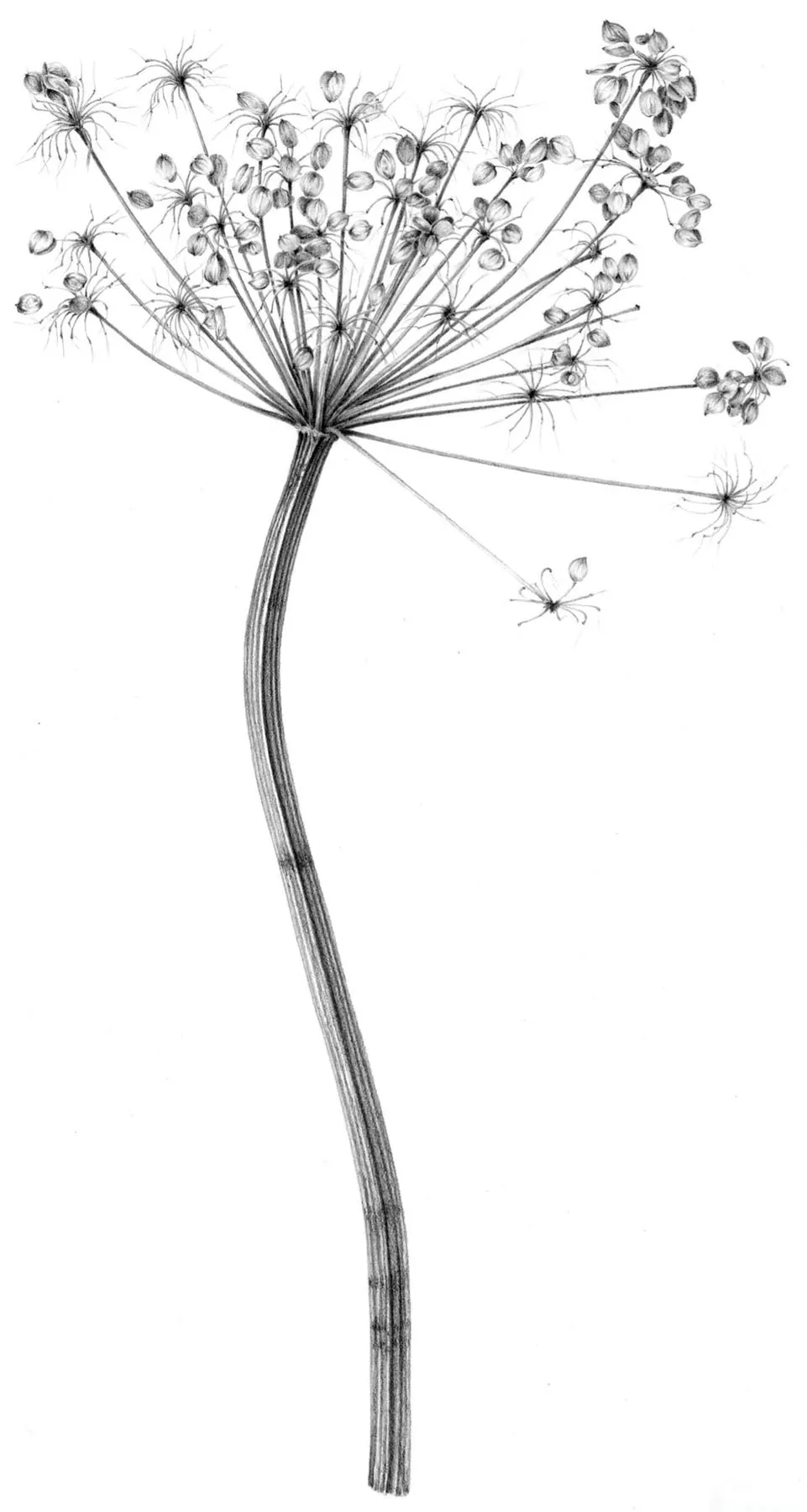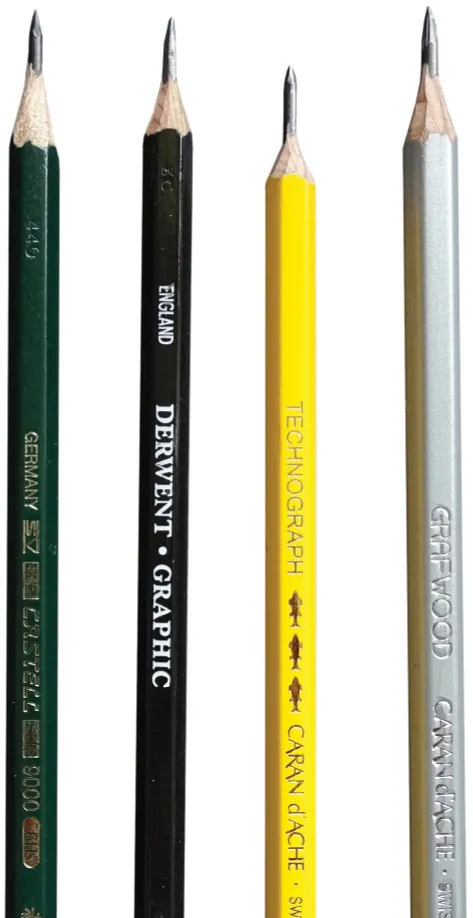![]()
CHAPTER 1
MATERIALS AND EQUIPMENT
Cow parsley (Anthriscus sylvestris) – graphite pencil.
We have a whole wealth of art materials available to us, with many art shops and Internet-based stores selling an abundance of wonderful things, often too tempting to ignore. It is important, however, to make sure that whatever we buy is of the best quality that we can afford, ensuring more than just acceptable results to be gained from our artwork. Each individual has different likes and requirements, and what suits one may not necessarily suit another, so listen to advice but don’t always go on someone else’s recommendation. Instead, wherever possible try something out before making an expensive purchase to make sure that it really is for you. Many types of both graphite and coloured pencil are available. Always buy artists’-quality pencils rather than cheaper ones: the results will be far superior. Seek outlets where it is possible to buy a replacement single pencil for the time when a favourite colour or grade is worn down to a stump.
GRAPHITE PENCILS
Wood-encased graphite pencils (left to right): Faber-Castell 9000, Derwent Graphic, Caran d’Ache Technograph 777, Caran d’Ache Grafwood.
I prefer to use wood-encased graphite pencils rather than the mechanical type. I enjoy the shape of the hexagonal barrel, the smell of the cedar that encases them, and the traditional way of sharpening them by hand with a blade.
HB grading
HB grading chart – there are many shades within a set of graphite pencils. The higher the number in the H grades, the harder and lighter the pencil. The B grades are much softer than the H grades: the higher the number, the softer and blacker the pencil.
We all know of the HB pencil and the amazing work that can be achieved with its use, but by getting to know the other nineteen ‘colours’ or grades of graphite, and working with them accordingly, your drawing skills will go from strength to strength.
Graphite pencils are graded by the amount of graphite and clay that they contain and are numbered from low to high. An HB pencil sits right in the middle of the range, containing equal amounts of both.
H GRADES – The H on a pencil denotes ‘hard’. It contains less graphite than the B range, and more clay. The higher the number next to the H (5H for example), the less graphite the pencil contains and the harder and lighter in tone or depth it will become.
B GRADES – The B stands for ‘blackness’. The B pencils contain more graphite and less clay than the H range. The higher the number, the more graphite it will contain and therefore the softer and darker the pencil will be.
F GRADE – The F grade pencil sharpens to a fine or firm point. This grade is only just on the harder side of the scale and comes between the HB and the H.
The shade, or tone, of graphite pencils may differ between manufacturers, so it is always worth making ‘colour’ charts of all pencils that you may have, such that you can feel and see the differences between them. Historically, pencils were marked just using the H and B as a scale. Those marked HH were very hard and those marked HHBBB were very hard and exceptionally black. Nowadays, most pencil manufacturers use the HB system with designated numbers to indicate the degree of hardness.
Numerical Grading
Some graphite pencils are graded with numbers such as 2½ or 3. There are four major grades, sometimes with intermediate numbers in between. The higher the number, the harder the pencil and the lighter it will be in its application.
Numerical Grading | HB Grading equivalent |
0 | B |
1 | HB |
2½ | F |
3 | H |
4 | 2H |
NON-SOLUBLE COLOURED PENCILS
Coloured pencil cores range from hard bias to soft depending on the manufacturer. Although a very personal choice, it is beneficial to have a selection of both. Listed are the coloured pencils that I use, and my thoughts on each.
Soft bias
The listed soft pencils are wax based, that is having wax as a carrier for the colour pigment. The softer ranges of pencils tend to apply colour instantly to the paper so need to be used with a very light touch. The points wear down quickly and can sometimes break and so are not really suitable for fine work, such as close detail or crisp clean edges, but they are ideal for intense colours over a large area. When applying a soft pencil you may find that the tooth of the paper shows as little white flecks through the applied colour, so you might need to use a harder type of pencil, or a blender or burnisher over the top at the final stage to press the tooth down to create a smoother effect.
The coloured pencils that I use (left to right): Karisma, Prismacolor, Derwent Coloursoft, Faber-Castell Polychromos, Derwent Artists, Derwent Studio, Prismacolor/Berol Verithin.
KARISMA
Sadly the Karisma range, from Sanford, is no longer manufactured, although a few odd colours may still be found lurking in the back of some art shops and on the Internet. Due to their scarcity, they tend to fetch high prices now, so if you spot a bargain it might be worth investing if you enjoy working with softer pencils.
PRISMACOLOR
Prismacolor, also from the American company Sanford, are available in 150 colours. These are waxy pencils and exceptionally soft, similar to a high graphite B grade. They have the same feel and colour range as Karisma, although they do have a tendency to break while sharpening. To avoid breakage, make sure you use a pencil sharpener with a good blade, rotating the pencil within it slowly and carefully. Prismacolor have some very useful colours such as Black Grape and Black Cherry and some really intense true reds.
DERWENT COLOURSOFT
The full set has 72 colours all with delicious sounding names, having a good range of natural colours, although not many ‘botanical’ greens. Coloursoft pencils hold their points well while being sharpened, and perhaps feel a little ‘chalky’ in comparison to the Karisma or Prismacolor range.
Medium to medium/hard bias
I find medium to medium/hard range coloured pencils the most suitable pencils to use for botanical drawing, as they hold a good point for fine detail whilst also giving good coverage over larger areas.
FABER-CASTELL POLYCHROMOS
The Polychromos range is oil based and there are 120 beautiful colours within the set, including some of my favourite greens, although it lacks some of the very pale pastel shades that can be found in the Derwent Artists range. Some of the colours are quite strong; when used lightly they produce a whole range of tones and are ideally suited for botanical artwork. They blend well with other makes and make a great set in combination with the Derwent Artists or Studio range.
DERWENT ARTISTS
A wax-based pencil with controllable colours that are light in application. The set of 120 colours has a great range, including some amazing subtle shades ideal for botanical work and some lovely soft pastel pinks that are just right for pale flower blossom. I also find the Artists range perfect for adding a final layer to apply a glaze or to use as a blender.
DERWENT STUDIO
Intended for use in the studio, hence its name, the wax-based Studio shares the same colour range as the Artists. The difference between the Artists and Studio is the size of the inner core, and the size and hexagonal shape of the barrel, the Studio being thinner. The full set of 72 lacks some of the pastel colours that are included in the Artists range.
Hard bias
PRISMACOLOR/BEROL VERITHIN
The clue is in the title: a thin, hard, wax-based pencil that holds the point really well, being ideal for detailed work and clear edges. The Verithin may be compared to an H grade graphite pencil in hardness, and can be quite transparent in its application.
WATER-SOLUBLE COLOURED PENCILS
Water-soluble coloured pencils (left to right): Karisma, Staedtler, Derwent Metallic, Derwent Inktense, Derwent Watercolour, Caran d’Ache Supracolor and Prismalo.
Watercolour pencils, which have a water-soluble gum as a binder, can be used as a dry pencil. In general they can be mixed with other types, such as Polychromos and Artists, although if you are in any doubt try them first on a scrap piece of paper before you apply them to your drawing. Watercolour pencils are usually identified as such within the labelling on the barrel of each pencil, but occasionally the only indication that they are water-soluble is a small symbol of a water drop or a little brush. If the pencil has previously been used with water, the point may have become crumbly within the pencil shaft. To avoid any problems that might be encountered while applying it dry, remove the point and at least 1 cm of the wood with a pencil sharpener before use...






